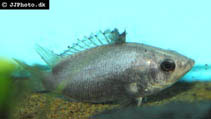| Family: |
Nandidae (Asian leaffishes) |
| Max. size: |
12.5 cm SL (male/unsexed) |
| Environment: |
benthopelagic; freshwater |
| Distribution: |
Asia: India: currently only known from the Ichamati River drainage in northeastern. The Ichamati River (not to be confused with a tributary of the Brahmaputra River with a similar name in Bangladesh) is a tributary of the Hooghly River, itself part of the Ganges River drainage. |
| Diagnosis: |
Dorsal spines (total): 12-14; Dorsal soft rays (total): 11-14; Anal spines: 3-3; Anal soft rays: 7-8. This species differs from its congeners by its pale bluish-white body color in life (vs. mottled brown); differs from Nandus nandus, the only South Asian congener, in having body depth 24.3-29.1% SL (vs. 28.2-34.3); pelvic fin length 16.2-18.9% SL (vs. 18.0-21.2); from Nandus nebulosus, Nandus oxyrhynchus and Nandus prolixus by the presence (vs. absence) of dark spot on the caudal peduncle, by having lateral line scales 45-52 (vs. 24-37) and body depth 24.3-29.1% SL (vs. 30.7-44.1) (Ref. 75197). |
| Biology: |
|
| IUCN Red List Status: |
Data deficient (DD); Date assessed: 28 October 2009 Ref. (130435)
|
| Threat to humans: |
harmless |
Source and more info: www.fishbase.org. For personal, classroom, and other internal use only. Not for publication.

